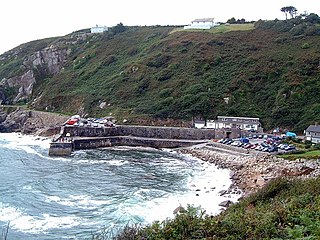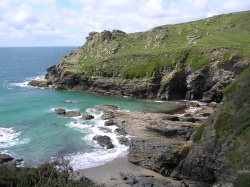
Lamorna is a village, valley and cove in west Cornwall, England, UK. It is on the Penwith peninsula approximately 4 miles (6 km) south of Penzance. Lamorna became popular with the artists of the Newlyn School, including Alfred Munnings, Laura Knight and Harold Knight, and is also known for former residents Derek and Jean Tangye who farmed land and wrote "The Minack Chronicles".

Dorothy Pentreath was a Cornish fishwife from Mousehole. She is one of the last known fluent speakers of the Cornish language. She is also often credited as the last known native speaker of Cornish, although sources support the existence of other younger speakers of the language who survived her.

John Harris FRHS was a Cornish poet. He became a fellow of the Royal Historical Society in April 1879 for being ″distinguished in letters″.
Breage or Breaca is a saint venerated in Cornwall and South West England. According to her late hagiography, she was an Irish nun of the 5th or 6th century who founded a church in Cornwall. The village and civil parish of Breage in Cornwall are named after her, and the local Breage Parish Church is dedicated to her. She is a saint in the Eastern Orthodox Church and Catholic Church.

The hundreds of Cornwall were administrative divisions or Shires (hundreds) into which Cornwall, the present day administrative county of England, in the United Kingdom, was divided between c. 925 and 1894, when they were replaced with local government districts.
Alfred Kenneth Hamilton Jenkin was a Cornish bard and historian with a particular interest in Cornish mining, publishing The Cornish Miner, now a classic, in 1927.

Gunwalloe is a coastal civil parish in Cornwall, England, United Kingdom. It is situated on the Lizard Peninsula three miles (4.8 km) south of Helston and partly contains The Loe, the largest natural freshwater lake in Cornwall. The parish population including Berepper at the 2011 census was 219. The hamlets in the parish are Chyanvounder, Berepper and Chyvarloe. To the east are the Halzephron cliffs and further east the parish church.

Prussia Cove, formerly called King's Cove, is a small private estate on the coast of Mount's Bay and to the east of Cudden Point, west Cornwall, England, United Kingdom. Part of the area is designated as a Site of Special Scientific Interest (SSSI), a Geological Conservation Review site and is in an Area of Outstanding Natural Beauty (AONB). It consists of four small coves and several cottages and houses. The names of the coves from west to east are Piskies, Bessy's, King's and Coule's. The area is accessible by foot from the South West Coast Path The cove is known for the 18th-century ship-wrecker and smuggler John Carter, also known as the "King of Prussia".

Germoe is a village and civil parish in Cornwall, England, United Kingdom. Germoe village, the parish's main settlement and church town, is about five miles (8 km) west of Helston and seven miles (11.3 km) east of Penzance. The A394 Penzance to Helston road runs along the southern border of the parish. Other settlements in the parish include Balwest, Boscreege and Tresowes Green.

Nanjizal, also known as Mill Bay, is a beach and cove in the civil parish of St Levan, Cornwall, on the south-western coast of Great Britain. Situated one mile to the south-east of Land's End, Nanjizal has no direct access via road, and is usually reached via the South West Coast Path from Land's End in the north, or from Porthgwarra to the south. Nanjizal is also a noted bird watching location.
Cruel Coppinger is a semi-legendary figure in Cornish folklore. Coppinger was a real person, but various legends grew up around him, lending him near superhuman powers and a fearsome reputation. He is portrayed as huge and fearsome Dane who after being shipwrecked off Cornwall became the leader of a feared band of smugglers.
Richard Spurr (1800–1855) was a Cornish cabinet maker and lay preacher who was imprisoned for his part in leading the political movement Chartism.

Fishing in Cornwall, England, UK, has traditionally been one of the main elements of the economy of the county. Pilchard fishing and processing was a thriving industry in Cornwall from around 1750 to around 1880, after which it went into an almost terminal decline. During the 20th century the varieties of fish taken became much more diverse and crustaceans such as crab and lobster are now significant. Much of the catch is exported to France due to the higher prices obtainable there. Though fishing has been significantly damaged by overfishing, the Southwest Handline Fishermen's Association has started to revive the fishing industry. As of 2007, stocks were improving. The Cornwall Sea Fisheries Committee is one of 12 committees responsible for managing the corresponding Sea Fisheries District. The Isles of Scilly Sea Fisheries Committee is responsible for the Scilly district.
Major General David Noel Hugh Tyacke CB OBE was a senior British Army officer. His last post was as General Officer Commanding the Singapore District. He had previously been the last commanding officer of 1st Battalion, Duke of Cornwall's Light Infantry (DCLI) prior to its amalgamation into the Somerset and Cornwall Light Infantry.
Edward Boscawen was an English politician who sat in the House of Commons variously between 1659 and 1685.

Pengersick Castle is a fortified manor house located between the villages of Germoe and Praa Sands, in the civil parish of Breage, in Cornwall, England. The tower house, which is in the parish of Breage, is a Grade I listed building. Parts of the building date from the early 16th century.

Acton Castle is a small castellated mansion near Perranuthnoe, Cornwall. It is a Grade II* listed building. It was built c. 1775, and according to some sources around 1790, by John Stackhouse of Pendarves, who was a distinguished botanist with an interest in seaweed and plants mentioned by Theophrastus. Stackhouse constructed the castle, with the main purpose of studying marine algae. The primary material used for the construction is granite, with the facade and the chimneys made of dressed granite. It has a grouted roof with walls topped by embattled parapets. Wings of two storeys, with tripartite windows, were added at the beginning of the 20th century during its conversion to a country hotel.

The Mermaid of Zennor is a Cornish folk tale which originates in the village of Zennor. The legend tells the story of a mysterious woman who occasionally attended the parish church of Zennor; a young man followed her home one day, and neither were seen again. One Sunday, a mermaid appeared to a group of local sailors, asking that they raise their anchor to let her enter her home, and the villagers concluded that she was the same woman who had attended their church. The legend is associated with a carved bench-end in the church, which depicts a mermaid.

Identifying the last native speaker of the Cornish language was a subject of academic interest in the 18th and 19th centuries, and continues to be a subject of interest today. The traditional view that Dolly Pentreath (1692–1777) was the last native speaker of the language has been challenged by records of other candidates for the last native speaker, and additionally there are records of others who had knowledge of the language at a later date, while not being native speakers.













